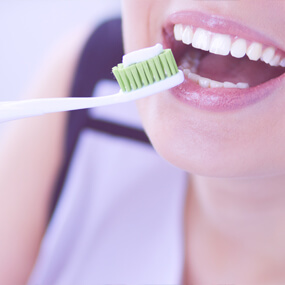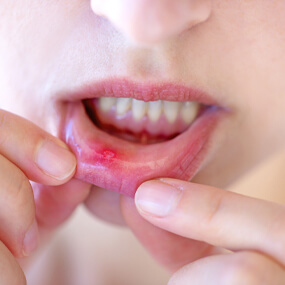How to Make Your Teeth and Gums as Healthy as Possible

Gum disease is the result of bacteria carried in plaque and tartar. Plaque is a film that adheres to your teeth and gums. In addition to harmful bacteria, plaque is made up of mucus, food, and other particles. Plaque that is not removed eventually solidifies and becomes tartar. According to the American Dental Association (ADA), tartar gives an even better home to the bacteria that can inflame gums, which is a condition known as gingivitis. While most plaque can be removed at home, tartar can generally only be removed by a dentist or a dental hygienist.
Gum Disease Has Three Stages:
- Gingivitis – During this early stage, gums are often red, swollen, and tender, and they will often bleed easily. Caught early enough, gingivitis can be reversed just through regular brushing and flossing.
- Mild to Moderate Periodontitis – The second stage involves an even greater degree of inflammation as well as bleeding near teeth in the affected areas. This happens due to the bacteria poisoning the gums but also because your immune system is inadvertently breaking down the bond between the teeth and gums. As these bonds weaken, the gums recede from the teeth, which creates infected pockets. Minor bone loss around the teeth may occur at this point, and treatment becomes critical in order to avoid even more serious bone loss as well as loosening of your teeth.
- Advanced Periodontitis – This advanced stage often involves deepening of the gum pockets as well as greater erosion of the bones that hold your teeth in place. Teeth may loosen to the point that periodontal treatment can not restore the bone support, and so, the teeth must be removed.
Symptoms and Causes of Gum Disease
Gum disease symptoms may not appear until the condition is advanced. These symptoms include:
- Sensitive teeth
- Bleeding gums
- Receding gums
- Lasting bad breath
- Gum redness, swelling, and tenderness
- Pain when chewing
- Loose teeth
The risk factors for gum disease include:
- Poor oral hygiene
- Smoking cigarettes and cigars
- Chewing tobacco
- Diabetes
- Some medications
- Female hormonal changes
- Genetics
Preventing Gum Disease
An oral hygiene regimen that includes brushing twice a day and flossing staves off cavities, gum infections and tooth loss. The ADA also recommends seeing your dentist at least twice a year. Professional dental cleanings are imperative to eliminating all plaque and tartar, and if you already have some stage of gum disease, your dentist may recommend additional checkups. Be mindful that no matter how well and consistently you brush and floss, plaque and tartar can still accumulate and require the attention of a dental professional.
Brushing
Brush in the morning and again before bedtime. Opt for a soft-bristled toothbrush, and an electric toothbrush is a worthwhile investment. Opt for a toothpaste that contains fluoride.
Position your brush at a 45-degree angle to your gums. Brush each tooth approximately 20 times. Avoid scrubbing. Use short, gentle strokes. Use back-and-forth strokes for the outer sides and crowns. For the inner sides, use downward strokes for the upper teeth and upward strokes for the lower teeth.
The ADA recommends replacing your toothbrush every three to four months or whenever it is fraying or shows other visible signs of wear. Whenever you have a cold or a more serious illness, you should replace your toothbrush as soon as you feel well. Also, avoid storing your toothbrush in a closed container, which can encourage the growth of harmful bacteria.
Flossing
Flossing removes food that has become trapped between the teeth as well as plaque that has accumulated on the teeth and along and under the gums.
Use approximately 18 inches of floss. Wrap the ends around your middle fingers, and let your index fingers serve as guides as you floss. Place the floss between the teeth and guide it up and down gently.
When reaching the gumline, curve the floss around one of the teeth. The floss should dip below the gumline as you gently move the floss up and down. Repeat this process with each and every tooth, and as you do, be sure to floss against the backside of your rear teeth.
Diet
What you eat and drink can contribute to tooth decay due to the bacteria in your mouth. This means that you should avoid sweets, particularly sticky sweets like soft candies, pastries, toffees, taffies. When you do eat sweets, rinse vigorously with plain water immediately afterward. When you chew gum, opt for a sugar-free brand.
It also helps to enrich your diet with milk, cheese, yogurt, and other calcium-rich foods. Calcium helps to strengthen the bone to which your teeth attach. A calcium-rich diet is particularly important for senior adults as well as children who are developing their primary and permanent teeth.
Realize Your Perfect Smile
A perfect smile is white and beautiful and instills you with confidence. It is also free of discomfort and harmful bacteria, and it is sustainable through a foundation of positive oral health. Scottsdale Cosmetic Dentistry Excellence is the practice of Jeffrey D. Clark, DDS, and among the leading dental offices in the region. Dr. Clark can give you personalized advice for your at-home dental hygiene as well as perform any in-office preventative and restorative dental care you may require. Call 480 585 1853 today to learn more.




